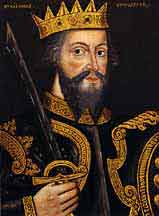 William I, the Conqueror
William I, the ConquerorNorman Line -- Reigned: 1066-1087 c.1027-September 9, 1087
In 1047, William reasserted himself in the eastern Norman regions and, with the aid of France's King Henry I, crushed the rebelling barons. He spent the next several years consolidating his strength on the continent through marriage, diplomacy, war and savage intimidation. By 1066, Normandy was in a position of virtual independence from William's feudal lord, Henry I of France, and the disputed succession in England offered William an opportunity for invasion. Edward the Confessor attempted to gain Norman support while fighting with his father-in-law, Earl Godwin, by purportedly promising the throne to William in 1051. (This was either a false claim by William or a hollow promise from Edward; at that time, the kingship was not necessarily hereditary but was appointed by the witan, a council of clergy and barons). Before his death in 1066, however, Edward reconciled with Godwin, and the witan agreed to support Godwin's son, Harold, as heir to the crown. The council was anxious to keep the monarchy in Anglo-Saxon hands and away from another Danish king. William was enraged and immediately made plans to invade England, insisting that Harold had sworn allegiance to him in 1064. William was prepared for battle by August 1066 but high winds over the next several weeks prevented crossing the English Channel. The bad weather turned out to be an advantage for William because, as Harold Godwinson awaited William's arrival on England's south shore, Harold Hardrada, the King of Norway, invaded the north. Harold Godwinson's forces marched northward to meet the Norse at Stamford Bridge on September 25, 1066. Two days after the battle, William landed unopposed at Pevensey and spent the next two weeks pillaging the area and strengthening his position on the beachhead. Harold, victorious over Hardrada, heard of the invasion and recognized an opportunity to solidify his kingship. He turned his army south toward the Normans and the armies met on October 14, 1066 at Hastings. After hours of holding firm against William's unusual and highly effective battle tactics, the tired English were beaten. Harold and his brothers died fighting at Hastings, removing any further organized Anglo-Saxon resistance to the Normans. The earls and bishops of the witan hesitated in supporting William, but soon submitted and crowned him William I on Christmas Day 1066. But peace did not prevail and the kingdom was immediately besieged by armed uprisings, each ruthlessly crushed by the Normans. All of England was finally conquered and united in 1072. William punished the rebels by confiscating their land and allocating it to Normans. He was unmerciful in dealing with hostile regions and later uprisings in the northern counties near York failed because of artificial famine brought on by Norman destruction of food caches and farming implements. The arrival and conquest of William and the Normans radically altered the course of English history. But rather than attempt a wholesale replacement of Anglo-Saxon law, William fused continental practices with native customs. By disenfranchising Anglo-Saxon landowners, he instituted a brand of feudalism in England that strengthened the monarchy. Villages and manors were given a large degree of autonomy in local affairs in return for military service and monetary payments. The Anglo-Saxon office of sheriff was greatly enhanced: sheriffs arbitrated legal cases in the shire courts on behalf of the king, extracted tax payments and were generally responsible for keeping the peace. [Laws of William the Conquerer.] The Domesday Book was commissioned in 1085 as a survey of land ownership to assess property and establish a tax base. Within the regions covered by the Domesday survey, the dominance of the Norman king and his nobility are revealed: only two Anglo-Saxon barons that held lands before 1066 retained those lands twenty years later. All landowners were summoned to pay homage to William in 1086. William imported an Italian, Lanfranc, to take the position of Archbishop of Canterbury. Lanfranc reorganized the English Church, establishing separate Church courts to deal with infractions of Canon law. Although he began the invasion with papal support, William refused to let the church dictate policy within English and Norman borders. William died as he had lived: an inveterate warrior. On September 9, 1087 in Normandy he succumbed to complications of a wound received in the siege of Mantes. The Anglo-Saxon Chronicle provides a favorable review of William's twenty-one year reign:
He was certainly cruel by modern standards, and exacted a high toll from his subjects, but he laid the foundation for the economic and political success of England. About William the Conquerer Parents: Robert I, Duke of Normandy and Herleva of Falasia Significant Siblings: none Spouse: Mathilda (daughter of Count Baldwin of Flanders) Significant Offspring: Robert, William Rufus, Henry, and Adela
Contemporaries: Related Documents: Anglo-Saxon Chronicle, Part V, A.D. 1066 Battle of Hastings Norman Conquest Laws of William the Conquerer |
All rights reserved. For details and contact information: See License Agreement, Copyright Notice. |
 William, the illegitimate son of the Duke of Normandy, was born about 1027, spent his first six years with his mother in Falaise, and received the duchy of Normandy upon his father's death in 1035. A council consisting of noblemen and William's appointed guardians ruled Normandy but ducal authority waned under the Normans' violent nature and the province was wracked with assassination and revolt for twelve years.
William, the illegitimate son of the Duke of Normandy, was born about 1027, spent his first six years with his mother in Falaise, and received the duchy of Normandy upon his father's death in 1035. A council consisting of noblemen and William's appointed guardians ruled Normandy but ducal authority waned under the Normans' violent nature and the province was wracked with assassination and revolt for twelve years.